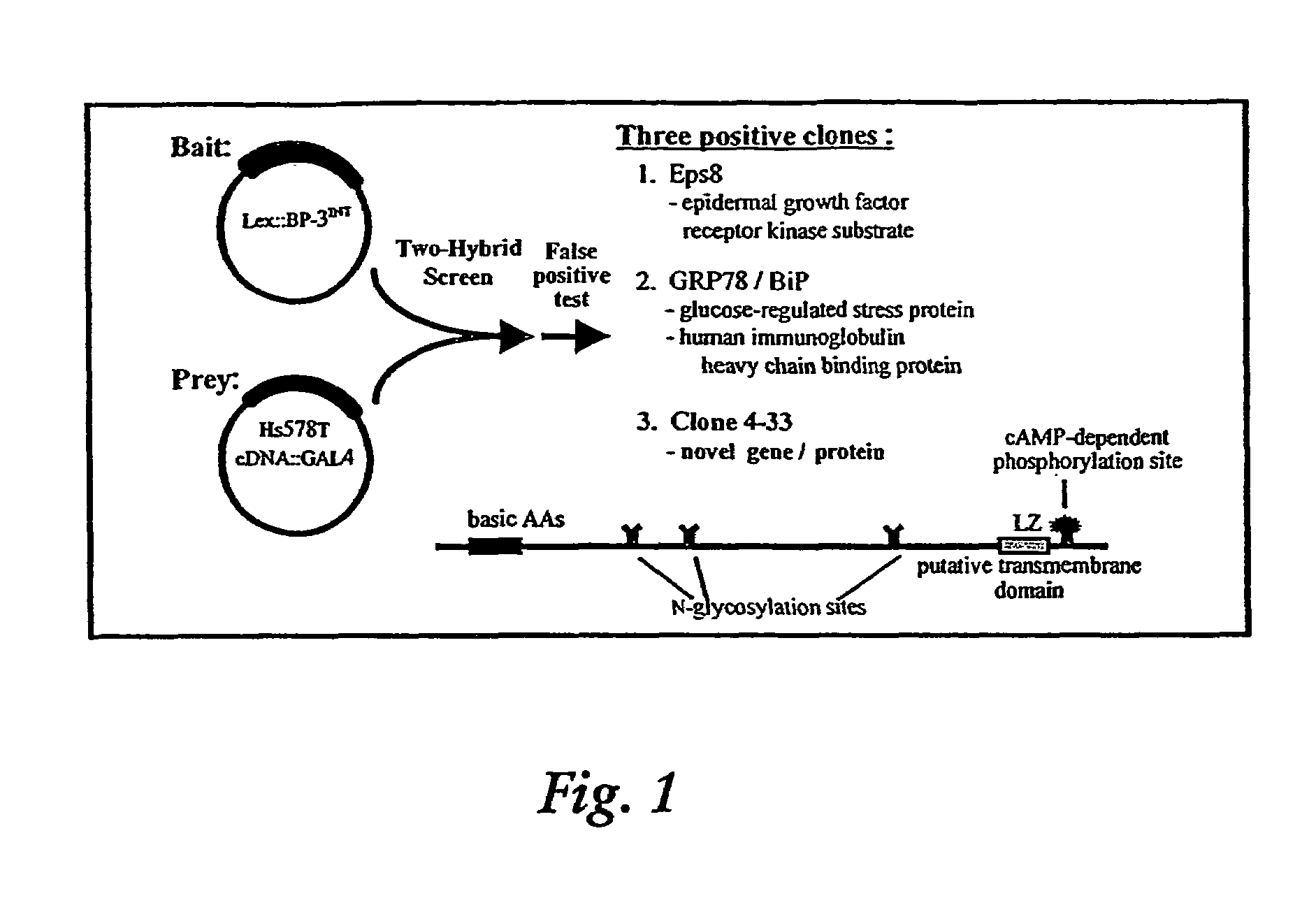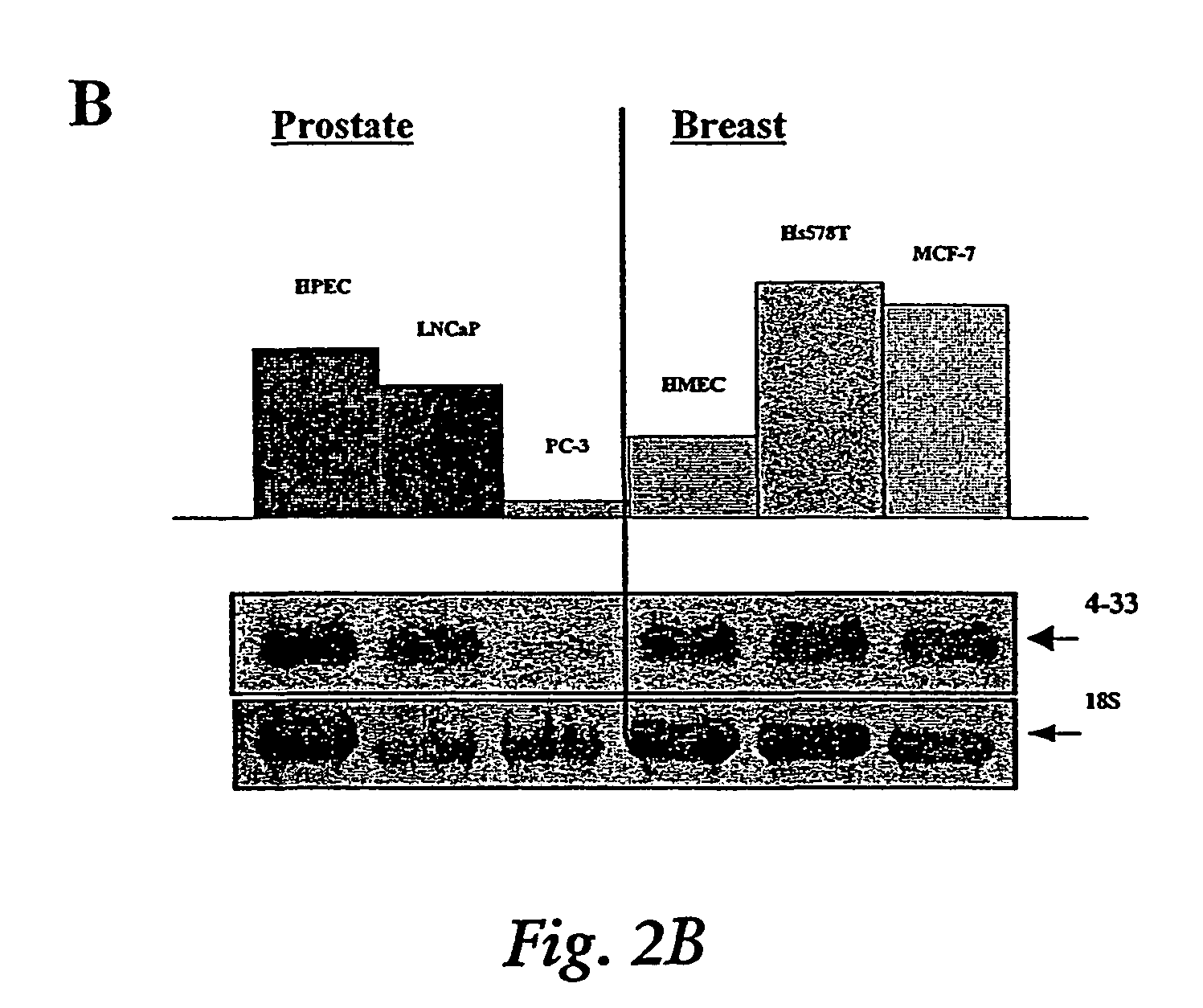Induction of apoptosis and cell growth inhibition by protein 4.33
- Summary
- Abstract
- Description
- Claims
- Application Information
AI Technical Summary
Benefits of technology
Problems solved by technology
Method used
Image
Examples
example 1
Cloning of a cDNA for a Novel IGFBP-3 Interacting Protein, P4.33
[0192]The following example of the present invention describes the cloning and isolation of clone 4.33, a cDNA encoding a novel IGFBP-3 interacting protein. The results show the discovery of a novel cDNA, 915 bp in length (SEQ ID NO:1), encoding a novel 240 amino acid protein (SEQ ID NO:2) that contains several N-glycosylation sites, a cAMP-dependent phosphorylation site, a single leucine-zipper motif (LZ), and a putative transmembrane domain near the C-terminus. See FIG. 2C.
Material and Methods
[0193]Yeast two-hybrid screen. An Hs578T cDNA library in pGAD10 was generated using the Two-Hybrid cDNA Library Construction Kit (Clontech). The “bait” plasmid was constructed by amplifying an internal sequence of the IGFBP-3 cDNA (encoding amino acids 88-148) by PCR, then cloning this fragment into the pBTM116 vector, in frame with the LexA DNA binding domain coding sequence. The bait plasmid was then transformed into yeast stra...
example 2
Cellular Localization of EGFP::4.33 Fusion Protein, and Cellular Colocalization and Co-Immunoprecipitation of IGFBP-3 and Clone 4.33
[0202]According to the present invention, the interaction between IGFBP-3 and clone 4.33 was confirmed by immunocytochemistry (FIG. 3A) and in coimmunoprecipitation studies (FIG. 3B). COS-7 cells were transiently transfected with or without constructs encoding an EGFP::4.33 fusion protein and FLAG-tagged IGFBP-3 (IGFBP-3F).
Material and Methods
[0203]Immunocytochemistry. Cells were seeded in 8-chamber culture slides (Nunc) and transfected at 70-80% confluency. After 48 hours, adherent cells were washed with PBS, fixed in 4% paraformaldehyde for 10 minutes at room temperature, and washed a further 3 times with PBS. Cells were then incubated in blocking solution (1% normal goat serum in PBS, 0.1% Triton X-100) for 1 hour at room temperature, followed by incubation with primary antibody diluted 1:1000 in blocking solution for 1-2 hours at room temperature. C...
example 3
Cellular Overexpression of Clone 4.33 Resulted in Increased Specific IGFBP-3 Cell-Surface Binding, and Co-Translocation to the Nucleus
[0212]According to the present invention, the binding of 125I-labelled IGFBP-3 to cells previously transfected with clone 4.33 was measured to determine whether the resulting expressed P4.33 could facilitate specific binding of IGFBP-3 to the cells (FIG. 4A).
Material and Methods
[0213]Cell culture, transfection, cell lysates, membrane preps. All cell lines, except the MCF-7:BP-3 stable lines, were purchased from ATCC. All were cultured in DMEM / high glucose with 10% fetal bovine serum. MCF-7:BP-3 stable lines were generated from wild type MCF-7 cells using the Ecdysone-inducible expression system (Invitrogen) according to the manufacturers instructions, and were maintained in DMEM / high glucose, 10% fetal bovine serum with 100 μg / mL Zeocin+800 μg / mL G418. IGFBP-3 protein production was induced with the addition of ponasterone A (Invitrogen) to the cultur...
PUM
| Property | Measurement | Unit |
|---|---|---|
| Inhibition | aaaaa | aaaaa |
| Cell growth | aaaaa | aaaaa |
Abstract
Description
Claims
Application Information
 Login to View More
Login to View More - R&D
- Intellectual Property
- Life Sciences
- Materials
- Tech Scout
- Unparalleled Data Quality
- Higher Quality Content
- 60% Fewer Hallucinations
Browse by: Latest US Patents, China's latest patents, Technical Efficacy Thesaurus, Application Domain, Technology Topic, Popular Technical Reports.
© 2025 PatSnap. All rights reserved.Legal|Privacy policy|Modern Slavery Act Transparency Statement|Sitemap|About US| Contact US: help@patsnap.com



